Summary
Between September 1990 and July 1991, we treated 17 patients with renal-cell carcinoma by radical nephrectomy and two patients with urothelial carcinoma of the kidney pelvis by ureteronephrectomy. Immediately after nephrectomy, perfusion of the kidneys with cold HTK solution was performed and the organs were kept in hypothermia of 8°C. The tumor-free parenchyma of the kidneys was treated 4 h later with shock waves of different energy levels in an experimental shock-wave system (Siemens Company, Erlangen). Light microscopy and examinations by scanning laser microscopy were performed after treatment. High-energy shock waves (HESW) produce significant changes in the tubulary and blood-vessel system of the viable human kidney, depending on the energy applied. Although our model is limited by hypothermia of the explanted kidneys, the effects of shock waves on the organs can be studied. Our model is suitable for testing the effects of different lithotriptors on the human kidney.
Similar content being viewed by others
References
Begun FP, Lawson RK, Kearns CM, Tien TM (1989) Electrohydraulic shock wave induces renal injury. J Urol 142:155
Begun FP, Knoll CE, Gottlieb M, Lawson RK (1991) Chronic effects of focused electrohydraulic shock waves on renal function and hypertension. J Urol 145:635
Bereiter-Hahn J, Seipel KH, Vöth M (1983) Fluorimetry of mitochondria in cells vitally stained with DASPMI or rhodamine 6 GO. Cell Biochem Function 1:147
Collins GM, Bravo-Shugarman MB, Terasaki PJ (1969) Kidney preservation for transplantation: initial perfusion and 30 hours ice storage. Candet 2:1219
Evan AP, McAteer JA, Steidle CP, Willis LR, Hockley N, Connors BA, Kempson SA, Lingeman JE (1989) Acute renal damage induced by ESWL in the mini-pig (abstract 233). J Urol 141:228A
Gilbert BR, Riehle RA, Vaughan ED Jr (1988) Extracorporeal shock wave lithotripsy and its effect on renal function. J Urol 139:482
Isemer FE, Ludwig A, Schurk O, Bretschneider HJ, Peiper HJ (1988) Kidney procurement with the HTK solution of Bretschneider. Transplant Proc 20:885
Jaeger P, Redka F, Uhlschmid G, Hauri D (1988) Morphological changes in canine kidneys followed extracorporeal shock wave treatment. Urol Res 16:161
Karlsen SJ, Berg KJ (1991) Acute changes in renal function following extracorporeal shock wave lithotripsy in patients with a solitary functioning kidney. J Urol 145:253
Karlsen SJ, Smevik B, Hovig T (1991) Acute morphological changes in canine kidneys after exposure to extracorporeal shock waves. Urol Res 19:105
Lingemann JE, Kulb TB (1987) Hypertension following extracorporeal shock wave lithotripsy. J Urol 137:142A
Morris JS, Husmann DA, Wilson T, Preminger GM (1991) Temporal effects of shock wave lithotripsy. J Urol 145:881
Newman R, Hachett R, Senior D, Brock K, Feldmann J, Sosnowski J, Finlayson B (1987) Pathologic effects of ESWL on canine renal tissue. Urology 29:194
Ryan PC, Jones BJ, Kay EW, Nowlan P, Kiely EA, Gaffney EF, Butler MR (1991) Acute and chronic bioeffects of single and multiple doses of piezoelectric shock waves (EDAP LT.01). J Urol 145:399
Wilbert DM, Bichler KH, Strohmaier WL, Fluchter SH (1988) Glomerular and tubular damage after extracorporeal shock wave lithotripsy assessed by measurement of urinary protein (abstract 656). J Urol 139:326A
Williams CM, Thomas WC Jr (1989) Permanently decreased blood flow and hypertension after lithotripsy. N Engl J Med 321:1269
Author information
Authors and Affiliations
Rights and permissions
About this article
Cite this article
Roessler, W., Steinbach, P., Nicolai, H. et al. Effects of high-energy shock waves on the viable human kidney. Urol. Res. 21, 273–277 (1993). https://doi.org/10.1007/BF00307710
Received:
Accepted:
Issue Date:
DOI: https://doi.org/10.1007/BF00307710




